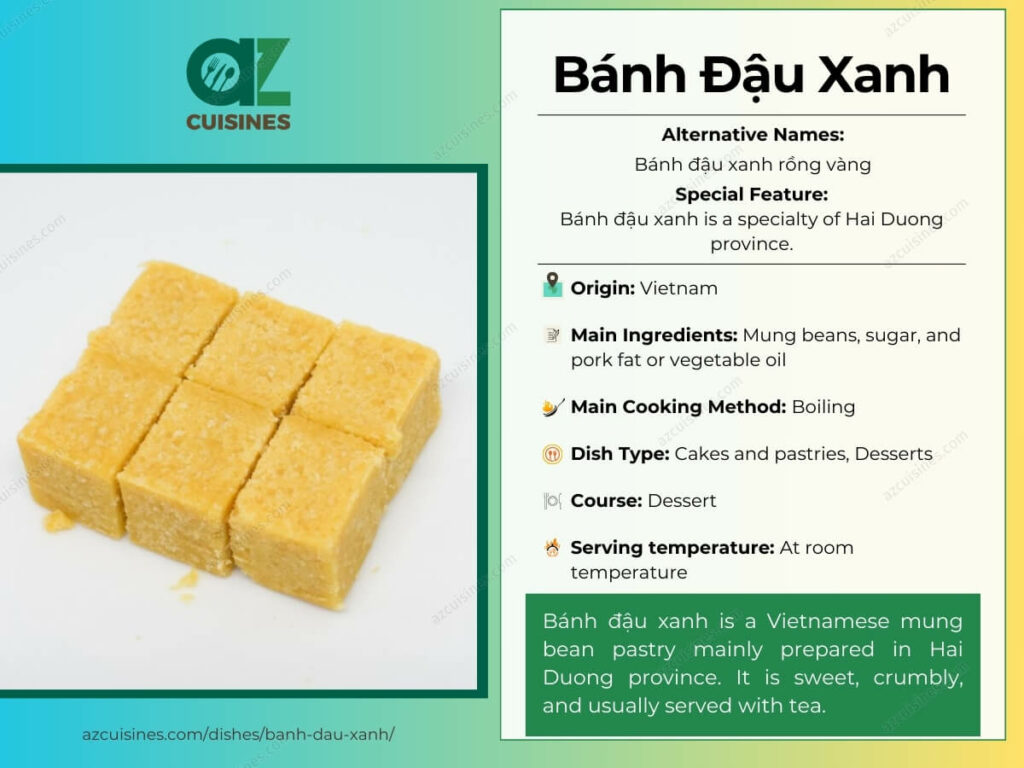#71 in Vietnam
Bánh Đậu Xanh: Basic Information
Pronunciation
Alternative Name(s)
Dish Type
Course
Mealtime
Popular Variations
Bánh Đậu Xanh: Ingredients and Preparation
Main Ingredients
Main Cooking Method
Preparation Process
Bánh Đậu Xanh: A Deep Dive
Cultural Significance
Taste
Texture
Aroma
Color
Serving Style
Serving Temperature
Accompaniment
Occasions
Seasons
Special Diets
Calories
Popularity
Popular Similar Dishes
- Lüdou Gao
- Besan Chakki
- Mysore Pak
- Soan Papdi
Popular Dining Area
Bánh đậu xanh, known as mung bean pastry in English, is a well-known sweet dish in Vietnam. Its main ingredients include peeled mung beans, sugar, and pork fat or vegetable oil. Aromatics, like vanilla or pomelo essential oil, are often added to the mix.
Bánh đậu xanh is usually cut into small cubes and wrapped in foil. This delicate kind of snack and dessert is very sweet and best enjoyed with tea.
Hai Duong Province in Northern Vietnam is famous for premium bánh đậu xanh, and I will tell you about the reasons shortly.
There are other exciting facts waiting for you, such as the advantages and disadvantages of consuming this traditional dessert, common concerns, and similar dishes.
Key Points
Why Is Hai Duong’s Bánh Đậu Xanh Famous?
Bánh đậu xanh from Hai Duong is well-known because of its excellent quality and the interesting story giving rise to its fame. Legend has it that Emperor Bảo Đại, Vietnam’s last monarch, once visited the province and tasted a sample of local mung bean pastry.
He was so delighted that he issued a letter of recommendation and allowed Hai Duong pastry makers to use the royal image of golden dragons as an act of patronage. Therefore, pastry from Hai Duong is usually called “bánh đậu xanh rồng vàng” (“golden dragon mung bean pastry”).
What advantages and disadvantages does this Hai Duong specialty have? The answer is right below!
Pros and Cons of Eating Bánh Đậu Xanh
Bánh đậu xanh offers the following benefits and challenges.
Pros
Cons
With these pros and cons in mind, let’s further your understanding of bánh đậu xanh by learning about how to cook it, store it, and other facts!




Truc Tran (Kris)
Senior Food Editor
Expertise
Home Cooking, Meal Planning, Recipe Development, Baking and Pastry, Food Editor, Cooking-video Maker, Vietnamese Food Evaluation Expert
Education
Truc Tran (Kris), an experienced food writer and editor, is great at exploring and describing global cuisines, from simple street food to fancy dining. In her writing, she skillfully mixes different flavors, cooking methods, and culinary traditions, showing the unique character of various cultures through their food and drinks. On azcuisines.com, Kris highlights her knowledge, especially in Asian cuisine and worldwide traditional dishes.